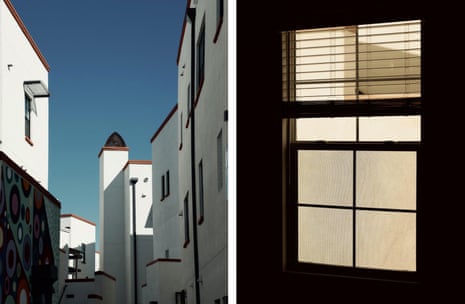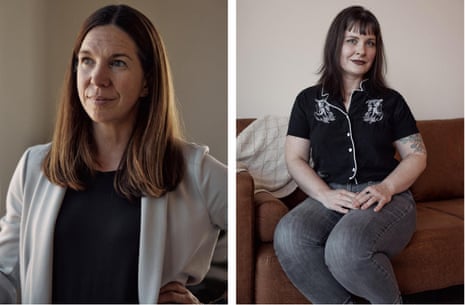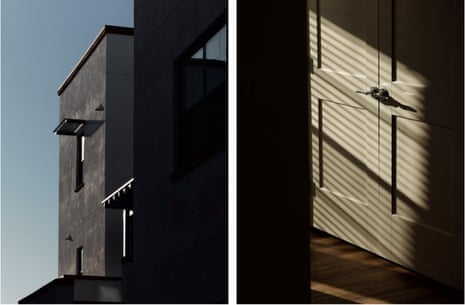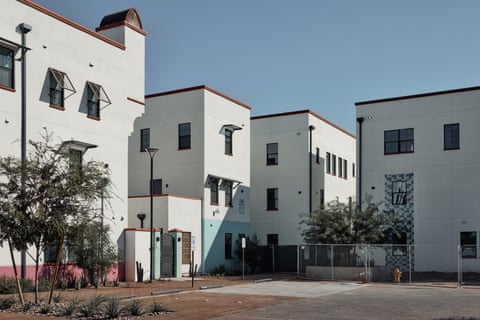If you were to imagine the first car-free neighborhood built from scratch in the modern US, it would be difficult to conceive such a thing sprouting from the environs of Phoenix, Arizona – a sprawling, concrete incursion into a brutal desert environment that is sometimes derided as the least sustainable city in the country.
But it is here that such a neighborhood, called Culdesac, has taken root. On a 17-acre site that once contained a car body shop and some largely derelict buildings, an unusual experiment has emerged that invites Americans to live in a way that is rare outside of fleeting experiences of college, Disneyland or trips to Europe: a walkable, human-scale community devoid of cars.
Culdesac ushered in its first 36 residents earlier this year and will eventually house around 1,000 people when the full 760 units, arranged in two and three-story buildings, are completed by 2025. In an almost startling departure from the US norm, residents are provided no parking for cars and are encouraged to get rid of them. The apartments are also mixed in with amenities, such as a grocery store, restaurant, yoga studio and bicycle shop, that are usually separated from housing by strict city zoning laws.
Neighborhoods of this ilk can be found in cities such as New York City and San Francisco but are often prohibitively expensive due to their allure, as well as stiff opposition to new apartment developments. The $170m Culdesac project shows “we can build walkable neighborhoods successfully in the US in [the] 2020s,” according to Ryan Johnson, the 40-year-old who co-founded the company with Jeff Berens, a former McKinsey consultant.

Johnson has the mien of a tech founder, with his company logo T-shirt and fashionable glasses, and was part of the founding team of OpenDoor, an online real estate business. But his enthusiasm for car-free living was born, he said, from living and traveling in countries such as Hungary, Japan and South Africa. Originally from the “classically sprawly” part of Phoenix, Johnson once had an SUV but has been car-free for 13 years. Instead, he has a collection of more than 60 ebikes, although he said he has stopped acquiring them as he is running out of storage space.
“Today in the US we only build two kinds of housing: single family homes that are lonely and have a painful commute, or we build these mid-rise projects with double loaded corridors and people mostly just walk to their car and that makes people know fewer of their neighbors,” said Johnson.
“We look back nostalgically at college, because it’s the only time most people have lived in a walkable neighborhood. People are happier and healthier, and even wealthier when they’re living in a walkable neighborhood.”

Culdesac is not only different in substance, but also style. The development’s buildings are a Mediterranean sugar-cube white accented with ochre, and are clustered together intimately to create inviting courtyards for social gatherings and paved – not asphalt – “paseos”, a word used in Spanish-speaking parts of the US south-west to denote plazas or walkways for strolling.
Importantly, such an arrangement provides relieving shade from the scorching sun – temperatures in these walkways have been measured at 90F (32C) on days when the pavement outside Culdesac is 120F (48C), the developer claims. The architects call the structures “fabric buildings” that form shared public realm, rather than charmless, utilitarian boxes situated next to a huge, baking car park.
“It’s positively European, somewhere between Mykonos and Ibiza,” said Jeff Speck, a city planner and urban designer who took a tour of Culdesac earlier this year. “It is amazing how much the urbanism improves, both in terms of experience and efficiency, when you don’t need to store automobiles.”

There is a small car park, although only for visitors, some disgorged by Waymo, the fleet of Google-owned driverless taxis that eerily cruise around Phoenix with their large cameras and disembodied voices to reassure passengers. To calm any nerves about making the leap to being car-free, Culdesac has struck deals to offer money off Lyft, the ride-sharing service, and free trips on the light rail that runs past the buildings, as well as on-site electric scooters. The first 200 residents to move in will be getting ebikes, too.
Such a place is an oddity, Speck points out, because of a car-centric ethos that permeates US culture and city planning. Over the past century, huge highways have been plowed through the heart of US cities, obliterating and dislocating communities – disproportionately those of color – leaving behind a stew of air pollution.

These roads have primarily served a sprawling suburbia, comprised almost entirely of single family homes with spacious back yards where car driving is often the only option to get anywhere. This car dependence has been reinforced by zoning laws that not only separate residential from commercial developments, but require copious parking spots added for every new construction. “The result is a nation in which we are all ruthlessly separated from most of our daily needs and also from each other,” Speck said.
Culdesac can be seen, then, as not only a model for more climate-friendly housing – transportation is the US’s largest source of planet-heating emissions and, studies have shown, suburban sprawl fuels more of the pollution causing the climate crisis – but as a way of somehow stitching back together communities that have become physically, socially and politically riven, lacking a “third place” to congregate other than dislocated homes and workplaces.
Culdesac residents have “this shared thing of living without a car” and can have the sort of chance encounters that foster social cohesion, according to Johnson, who himself lives in one of the airy apartments. “When we started, people said: ‘What are you doing? You’re not going to get permission to build that. The demand’s not going to be there,’” he said. “And instead, we got unanimous approval, and there’s a lot of demand, and it’s open. Residents love it.”

Vanessa Fox, a 32-year-old who moved into Culdesac with her husky dog in May, had always wanted to live in a walkable place only to find such options unaffordable. For her, Culdesac provided a sense of community without having to rely on a car every time she left her apartment. “For some, cars equal freedom, but for me, it’s a restriction,” she said. “Freedom is being able to just simply walk out and access places.”

Speck said that he expects closer relationships to form among residents. “We will soon have Culdesac babies,” he predicted.
Fox admits, though, that some of her family and friends consider her decision to go car-free to be somewhat of an oddity. The New York subway and railroad tycoons of yore may have found international fame, but in the US, the car now reigns supreme.
Around nine in 10 Americans own a car, with only a tenth of people using public transport – which is typically underfunded and has suffered badly since the Covid pandemic – on even a weekly basis. Even Joe Biden’s administration, which has talked of reconnecting communities and acting on climate change, is enthusiastically pushing hundreds of billions of dollars to building new highways.
Driving to places is so established as a basic norm that deviation from it can seem not only strange, as evidenced by a lack of pedestrian infrastructure that has contributed to a surge in people dying from being hit by cars in recent years, but even somewhat sinister. People walking late at night, particularly if they are Black, are regularly accosted by police – in June, the city of Kaplan, Louisiana, even introduced a curfew for people walking or riding bikes, but not for car drivers.
If neighborhoods like Culdesac are to become more commonplace, then, cities will not only have to alter their planning codes, but there will also have to be a cultural switch from the ideal of a large suburban home with an enormous car in the driveway. Some US billionaires have dreams of creating new utopian cities that have such elements, although urban planning experts point out it would be better for the environment if existing cities just became denser and less car-centric.

Johnson, who said he is planning to bring the Culdesac concept to other cities, is upbeat about this. “This is something that the majority of the US wants, so they can work all over the country,” he said. “We have heard from cities and residents all over the country that they want more of this, and this is something that we want to build more.”
“Every trend begins with a one-off,” Speck said. “True proliferation will be dependent upon our cities improving their transit and micro-mobility systems. But for those cities that offer a decent alternative to driving, there is a great fit immediately. Government officials should be asking themselves whether their cities are Culdesac-ready.”
This is the first in a new series, The alternatives, looking at governments and communities around the world who are trying out new ideas for low carbon living.
